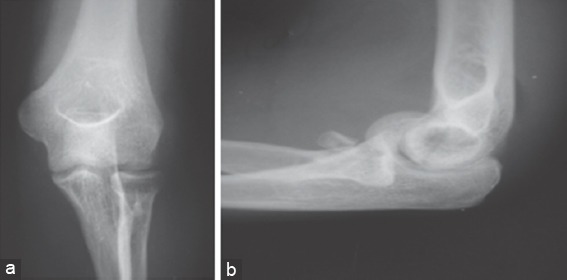Abstract
Introduction:
The coexistence of fractures of capitulum humeri and radial head in the elbow joint is a rare entity.
Case Report:
A 30-year-old woman was admitted to our hospital after having sustained a fall on her outstretched right arm. She complained of pain, swelling, and restriction of motion of the right elbow joint. Anteroposterior and lateral radiographs revealed displaced fractures in the capitellum and the radial head. The patient was operated. Fractures were exposed through a lateral (Kocher) incision. Fracture was reduced, and fixation was performed with 2 AO compression screw. Two fragments of radial head fracture were also reduced and fixed with AO compression screw. Clinical and radiographic outcomes were excellent at the end of a 5-year follow-up.
Conclusion:
These fractures occurred following a fall on the palm with outstretched arm. The success of the treatment depends greatly on surgical approach and suitable technique which requires comprehensive knowledge of detailed anatomy and biomechanics of the elbow.
Keywords: Elbow joint, fractures, surgery, internal fixation
What to Learn from this Article?
Despite the rarity of the coexistence of such fractures, surgeons should be aware of this entity for a prompt management. Open reduction and internal fixation is indicated and can be helpful in such condition.
Introduction
Isolated fractures of capitulum humeri and radial head are frequently encountered among fractures of the elbow. Coexistence of these fractures is rare. There are few case reports about this entity. This is a case report highlighting this combination of fractures in a 30-year-old female patient who was successfully managed.
Case Report
A 30-year-old woman was admitted to our hospital after having sustained a fall on her outstretched right arm. She complained of pain, swelling, and restriction of motion of the right elbow joint. Physical examination revealed generalized swelling of the elbow region and tenderness at radial head and lateral condyle. The stability of the elbow was considered normal. No neurovascular abnormalities were noted. Anteroposterior and lateral radiographs (Fig. 1) revealed a displaced Hahn-Steinthal fracture of capitellum, associated with Masson Type II displaced two-part fracture radial head. The patient was operated 36 h after the trauma. Fractures were exposed through a lateral (Kocher) incision. Capitellar fragment was of 1.5 cm × 1 cm dimensions, and it was reduced and fixation was performed with 2 AO compression screw. Two fragments of radial head fracture of 1 cm × 0.5 cm dimensions were also reduced and fixed with AO compression screw. Postoperatively, the patient was put on a splint for 2 weeks before the physiotherapy. At the latest follow-up at 5 years (Fig. 2), the patient was pain-free, having returned to preinjury occupation with full movements and evidence of elbow instability. The functional result was excellent according to a functional rating of Boberg and Morrey. Radiologic examination (Fig. 3) also showed normal anatomy without any signs of degenerative changes.
Figure 1.

Anteroposterior (a), lateral (b) radiographs of the right elbow showing lesions.
Figure 2.

Elbow movements were painless and full at 4th year postoperatively.
Figure 3.

Anteroposterior (a), lateral (b) radiographs of the elbow 5 years after operation.
Discussion
Isolated fractures of the capitellum or coronoid are rare. Radial head fractures constitute about one-third of the elbow fractures [1, 2]. There are only a few cases with capitellum and radial head fractures together [1, 3]. Radial head fractures may be complicated by the presence of associated lesions. One of the less-recognized is trauma to the capitellum [4, 5].
The capitellum is at risk because of reciprocal impinging on the radial head. This can be explained by the importance of the radiocapitellar contact surface: 60% of the axial load at the elbow is transmitted through the radiocapitellar joint. The capitellum is shorn from the humerus by the impact of the radial head. As a consequence, the capitellum may be fractured [4].
This injury seems to be due to varus force at the elbow with direct impact over lateral aspect of the elbow, which first results in a capitellum fracture. This force and the capitellum fragment would have hit the radial head leading to its impacted fracture [1]. In the present case, the patient had fall on her outstretched right arm explaining the occurrence of such combined fractures.
There are three types of capitellum fractures: Type I (Hahn-Steinthal fracture) contains a great portion of capitellum with the fracture line going down to lateral part of trochlea. Type II (Kocher-Lorenz) consists of anterior cartilaginous portion of capitellum with some subchondral bone. Type III (Boberg-Morrey fracture) is the comminuted fracture of capitellum [6].
Radial head fractures have been classified according to the Mason classification: Type I is a nondisplaced marginal fracture; Type II is a displaced marginal fracture; Type III is a comminuted fracture; Type IV is a fracture with dislocation of the elbow [6]. Our patient had Type I capitellum and Type II radial head fractures.
Detailed radiological examination is necessary for surgical planning. In fact, standard radiographic evaluation of radial head fractures includes AP and lateral views of the elbow. Because of the typical mechanism of injury (a load applied from distal to proximal), wrist views usually are advisable and, of course mandatory, if there are symptoms at the wrist [7].
Nondisplaced and minimally displaced radial head fractures can be treated with a sling or splint for a few days followed by early range of motion (ROM) [7, 8].
Although closed reduction and cast immobilization may be performed for the treatment, open reduction and internal fixation is more commonly suggested [7, 9]. In the present case, our surgical option included open reduction and internal fixation.
Thus, internal fixation of the radial head is technically demanding, owing to the small and often comminuted nature of the fragments as well as the circumferential articular cartilage on the head. For more simple fracture patterns involving impaction of a portion of the head, a limited approach can be effective. It must be noted that the traditional Kocher interval (extensor carpi ulnaris-anconeous interval) is well posterior to the axis of the radial head [10].
Treatment of displaced fractures is predicated on the extent of displacement and the size of fragments. When radial head fractures are comminuted, radial head resection or replacement is recommended more commonly because the comminuted fragments are not amenable to fixation [7]. In capitellar fractures, stable internal fixation using various materials including Kirschner wires or AO-compression screws combined with early ROM exercises can achieve optimal results [11, 12]. The mode of fixation largely depends on the fragment size and comminution. Screw fixation enables rigid stability and early movement [13].
Thus, from the results of our case, we attributed our successful outcomes to the suitable size of the capitellar osteochondral fragment and two fragments of the radial head for fixation.
Conclusion
Knowledge about the treatment of fractures of the elbow still under debate, this case demonstrates that good functional and anatomic results can be realized by open reduction and fixation with AO compression screws allowing early mobilization and a good recovery of elbow.
Clinical Message.
The particularity of such rare injury is the mechanism. Surgeons should be aware of this entity for a prompt management. Open reduction and internal fixation is indicated and can be helpful in such condition.
Biography





Footnotes
Conflict of Interest: Nil
Source of Support: None
References
- 1.Kumar V, Kumar A, Aggarwal S. A rare combination of fractures around the elbow:Bony variant of terrible triad. Chin J Traumatol. 2015;18(6):363–366. doi: 10.1016/j.cjtee.2015.06.003. [DOI] [PubMed] [Google Scholar]
- 2.Kaas L, van Riet RP, Vroemen JP, Eygendaal D. The incidence of associated fractures of the upper limb in fractures of the radial head. Strategies Trauma Limb Reconstr. 2008;3(2):71–74. doi: 10.1007/s11751-008-0038-8. [DOI] [PMC free article] [PubMed] [Google Scholar]
- 3.Keser S, Demirel N, Bayar A, Ege A. The coexistence of fractures of the capitellum and the radial head:A rare case. Acta Orthop Traumatol Turc. 2007;41(1):69–73. [PubMed] [Google Scholar]
- 4.Nalbantoglu U, Gereli A, Kocaoglu B, Aktas S, Turkmen M. Capitellar cartilage injuries concomitant with radial head fractures. J Hand Surg Am. 2008;33(9):1602–1607. doi: 10.1016/j.jhsa.2008.05.016. [DOI] [PubMed] [Google Scholar]
- 5.van Riet RP, Morrey BF, O’Driscoll SW, Van Glabbeek F. Associated injuries complicating radial head fractures:A demographic study. Clin Orthop Relat Res. 2005;441:351–355. doi: 10.1097/01.blo.0000180606.30981.78. [DOI] [PubMed] [Google Scholar]
- 6.Ward WG, Nunley JA. Concomitant fractures of the capitellum and radial head. J Orthop Trauma. 1988;2(2):110–116. doi: 10.1097/00005131-198802010-00004. [DOI] [PubMed] [Google Scholar]
- 7.Pappas N, Bernstein J. Fractures in brief:Radial head fractures. Clin Orthop Relat Res. 2010;468(3):914–916. doi: 10.1007/s11999-009-1183-1. [DOI] [PMC free article] [PubMed] [Google Scholar]
- 8.Rosenblatt Y, Athwal GS, Faber KJ. Current recommendations for the treatment of radial head fractures. Orthop Clin North Am. 2008;39(2):173–185. doi: 10.1016/j.ocl.2007.12.008. vi. [DOI] [PubMed] [Google Scholar]
- 9.Ring D, Quintero J, Jupiter JB. Open reduction and internal fixation of fractures of the radial head. J Bone Joint Surg Am. 2002;84A(10):1811–1815. doi: 10.2106/00004623-200210000-00011. [DOI] [PubMed] [Google Scholar]
- 10.Wysocki RW, Cohen MS. Surgical management of radial head fractures. Am J Orthop. 2007;46(2):62–69. [PubMed] [Google Scholar]
- 11.Kaushal R, Bhanot A, Gupta PN, Bahadur R. Isolated shear fracture of humeral trochlea. Inj Extra. 2005;36(6):210–211. [Google Scholar]
- 12.Nakatani T, Sawamura S, Imaizumi Y, Sakurai A, Fujioka H, Tomioka M, et al. Isolated fracture of the trochlea:A case report. J Shoulder Elbow Surg. 2005;14(3):340–343. doi: 10.1016/j.jse.2004.07.012. [DOI] [PubMed] [Google Scholar]
- 13.Sen RK, Tripahty SK, Goyal T, Aggarwal S. Coronal shear fracture of the humeral trochlea. J Orthop Surg (Hong Kong) 2013;21(1):82–86. doi: 10.1177/230949901302100121. [DOI] [PubMed] [Google Scholar]


